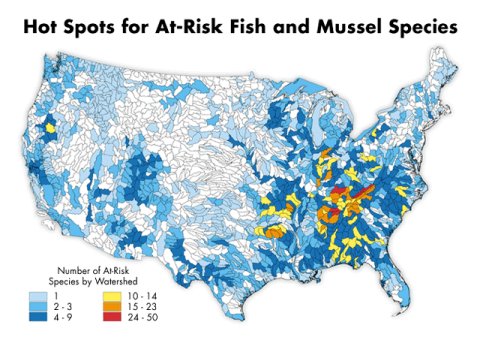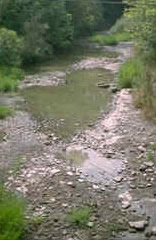Freshwater Ecosystems
Find out more about:
Freshwater ecosystems are aquatic systems which contain drinkable water
or water of almost no salt content. Freshwater resources include lakes and ponds, rivers
and streams, reservoirs, wetlands,
and groundwater. The United States derives
many benefits from these freshwater resources. They provide the majority
of our nation's drinking water resources, water resources for agriculture,
industry, sanitation, as well as food including fish and shellfish. They
also provide recreational opportunities and a means of transportation.
In addition, freshwater ecosystems are home to numerous organisms (e.g.,
fish, amphibians, aquatic plants, and invertebrates). It has been
estimated that 40% of all known fish species on Earth come from freshwater
ecosystems (NatureServe–
Rivers of Life: Critical Watersheds for Protecting Freshwater Biodiversity) ![]() .
Unfortunately, rivers and streams are also among the most endangered habitats.
.
Unfortunately, rivers and streams are also among the most endangered habitats.

Above:
Hotspot watersheds with 10 or more at-risk fish and mussel species
are concentrated in the U. S. Southeast, reflecting the extraordinary
freshwater diversity of rivers and streams in this region. From
NatureServe–
Rivers of Life: Critical Watersheds for Protecting Freshwater
Biodiversity)![]()
The rates of extinction of freshwater species and the number of endangered freshwater species are alarming. For example, the Nature Conservancy coupled with the Natural Heritage Network report that since the first European settlement, 21 out of 822 native American fish species have become extinct. A map of species at risk by watershed in the United States which illustrates that the Southeastern United States is experiencing some of the highest rates of risk (see map at left).
Species of concern include:
- two-thirds of the nation’s freshwater mussels are at risk of extinction; almost 1 in 10 may already have vanished forever.
- half of all crayfish species are in jeopardy
- over 40% stoneflies are at risk
- freshwater fishes and amphibians are doing little better, with about 40 percent of the species in these groups at risk
- dragonfly and damselfy species have about 18% at risk.

The World Resources Institute on Biodiversity has also reported that almost 50 percent of freshwater snails in the Southeastern United States are now endangered or extinct due to channelization and impoundment of rivers.
Some major groups of organisms known to inhabit freshwater ecosystems include vertebrates (e.g., fish, amphibians, reptiles, birds, and mammals), invertebrates (e.g., protozoan, myxozoans, rotifers, worms, mollusks), plants, algae, fungi, and bacteria. Infectious agents such as viruses may also be present. As in marine environments, phytoplankton and zooplankton form the base of the food chain. Periphyton, macrophytes (aquatic plants), insects, fish, and amphibians are also found in freshwater environments. Various birds species like osprey, ducks, raptors also frequent freshwater systems.
Despite all of their value and importance, many freshwater ecosystems are being severely damaged by human activities. The major threats to freshwater biodiversity include runoff from agricultural and urban areas, the invasion of exotic species, and the creation of dams and water diversion. Overexploitation and pollution also threaten groundwater supplies. These kinds of threats and others have already significantly impacted the biodiversity within these ecosystems.

If you are interested in learning more about freshwater ecosystems check out the following web sites:
- The Nature
Conservancy's Freshwater Initiative (FWI)

- The Nature Conservancy's On-line
Library

- The Freshwater Society

- Water
Resources & Freshwater Ecosystems

- WCMC
Biodiversity Series No. 8 - Freshwater Biodiversity: A Preliminary
Global Assessment

- The Conservation of Biological Diversity in the Great Lakes Ecosystem: Issues and Opportunities
- Great Lakes in the Balance
- Designing a Geography of Hope Update: Reflections of Current
Thinking and Conservations - Update
Number 6: Including Aquatic targets in Ecoregional Portfolios:
Guidance for Ecoregional Planning teams (PDF)
(24pp, 540KB)

- IUCN Global Freshwater
Initiative

- The
Nature Conservancy: Ecologically Sustainable Water Management

- The
Nature Conservancy: Freshwater Resources: The Declining Status
of Freshwater Biodiversity and National and International Water
Resources

You will need the free Adobe Reader to view some of the files on this page. See EPA's PDF page to learn more.
![[logo] US EPA](https://cybercemetery.unt.edu/archive/oilspill/20121017141250im_/http://www.epa.gov/epafiles/images/logo_epaseal.gif)